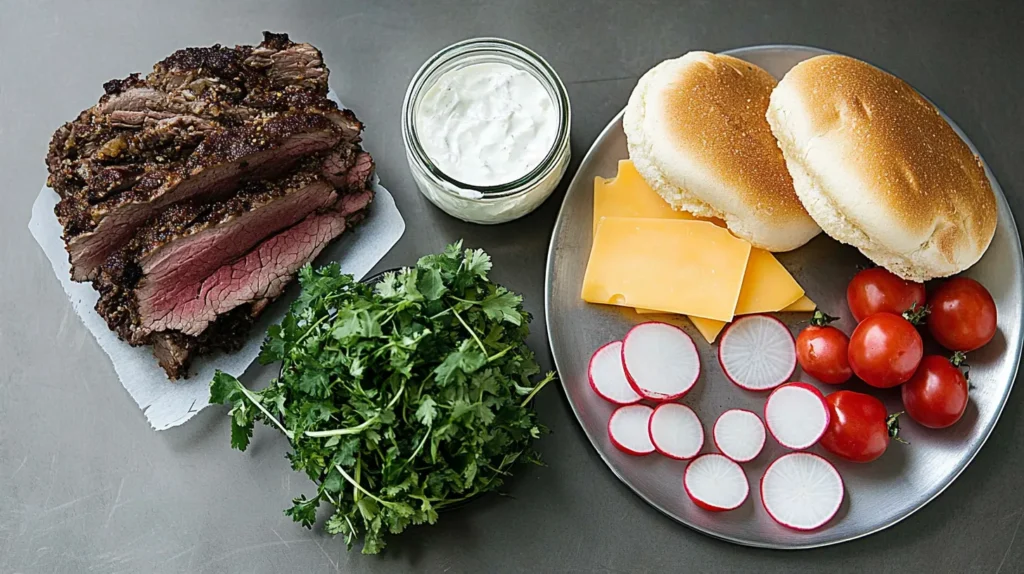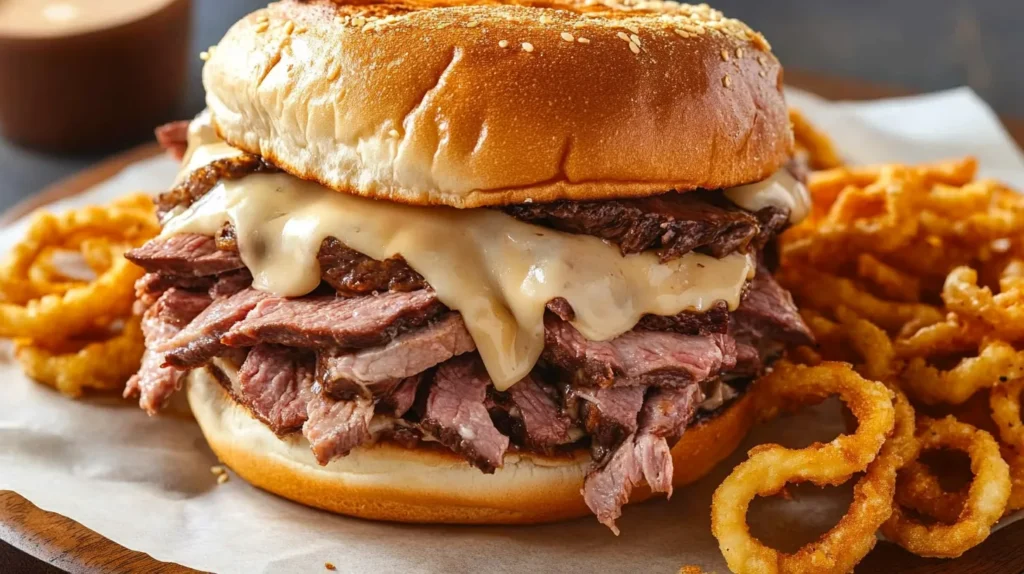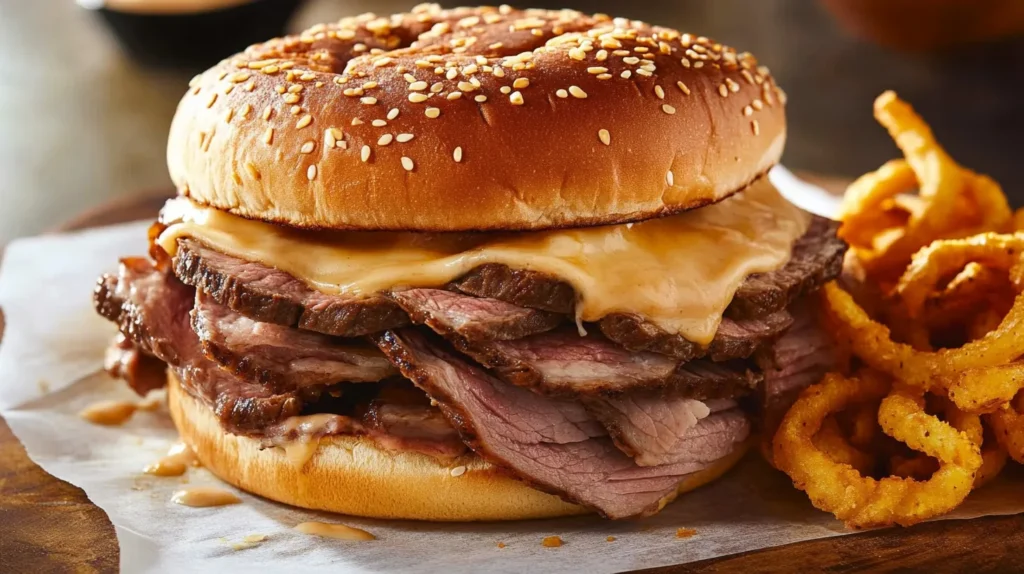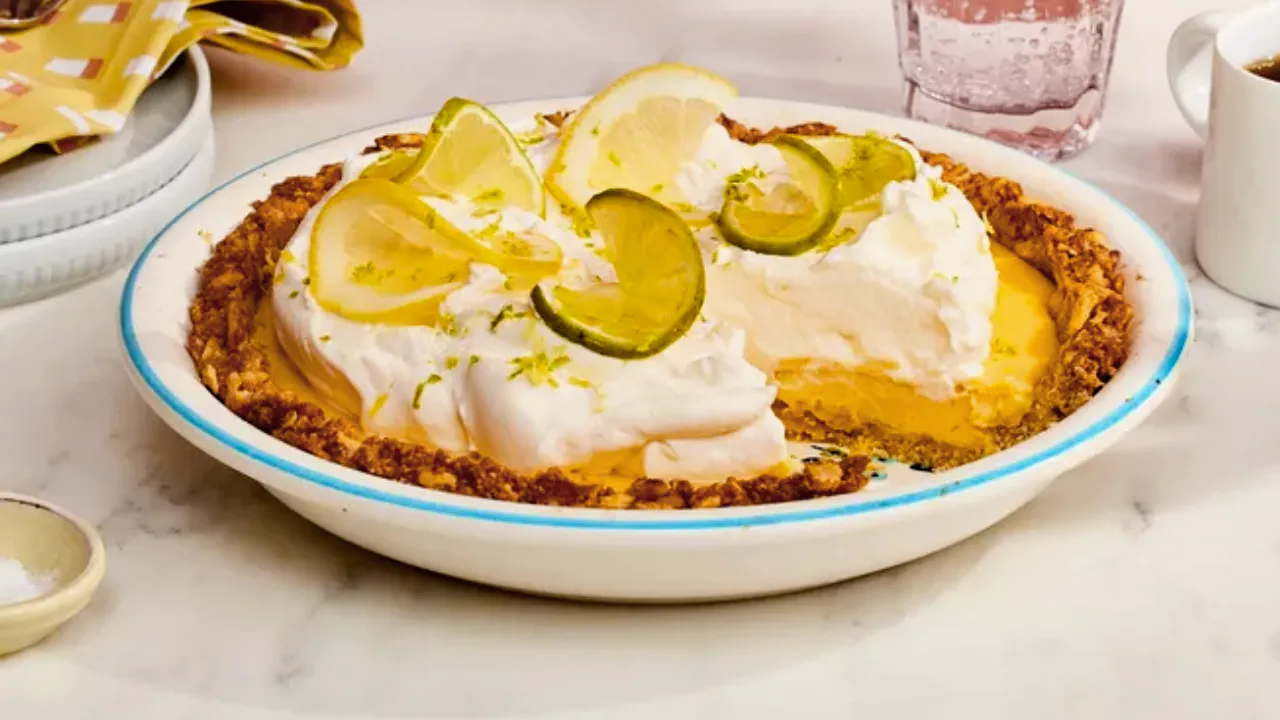Roast beef sandwiches are a timeless favorite, but what kind of meat is used for roast beef sandwiches? The answer depends on your flavor preferences, texture needs, and cooking methods. Whether you’re looking for a lean cut like top round or a rich, indulgent option like prime rib, the meat choice can make all the difference in crafting the perfect sandwich.
In this guide, we’ll explore the best cuts of meat for roast beef sandwiches, how to prepare them, and alternatives for those seeking something unique. Let’s dive in!
Why Meat Choice Matters for Roast Beef Sandwiches
The type of meat you choose for your roast beef sandwich greatly impacts its flavor, texture, and overall quality. Picking the right cut ensures a sandwich that’s both delicious and satisfying.
1. The Role of Meat in Flavor and Texture
- Flavor: The meat’s natural flavor, influenced by marbling and fat content, is the foundation of a great roast beef sandwich.
- Lean cuts provide a clean, beefy taste.
- Well-marbled cuts offer a richer, juicier flavor.
- Texture: The right cut ensures a tender, easy-to-bite sandwich. Tough or improperly sliced meat can detract from the sandwich experience.
- Thin slices enhance tenderness, even for lean cuts.
- A slight chew from the meat adds to the overall texture without being tough.
2. Popular Cuts for Roast Beef Sandwiches
Certain cuts are preferred for their balance of flavor, affordability, and ease of preparation. These include:
- Top Round: Lean and easy to slice, perfect for a classic deli-style sandwich.
- Bottom Round: More flavorful than top round, with a bit more chew.
- Sirloin Tip: A tender cut with just enough fat to remain juicy.
- Prime Rib: Rich and luxurious, ideal for indulgent sandwiches.
Pro Tip: Match the cut of meat to the sandwich style. For example, use a lean cut for cold deli sandwiches and a marbled cut for warm, juicy sandwiches.
The Best Types of Meat for Roast Beef Sandwiches
Selecting the right cut of meat is essential to crafting a roast beef sandwich that’s flavorful, tender, and satisfying. Here are the best types of meat commonly used for this classic dish.
1. Top Round: A Lean and Affordable Option
- What It Is:
- Taken from the rear leg of the cow, top round is a lean cut with a mild, beefy flavor.
- Why It Works:
- Its low fat content makes it ideal for thin slicing, especially for cold or deli-style sandwiches.
- Best Pairings:
- Pair top round with tangy condiments like horseradish or Dijon mustard to enhance its flavor.
Pro Tip: Marinate or season top round generously before roasting to bring out its full flavor.
2. Bottom Round: Flavorful and Versatile
- What It Is:
- A cut from the hindquarters, bottom round is slightly tougher than top round but has a richer flavor.
- Why It Works:
- Its balance of affordability and taste makes it a popular choice for home-cooked roast beef.
- Best Pairings:
- Works well with creamy condiments like mayonnaise or aioli and softer breads like brioche.
Pro Tip: Slow-cook or roast bottom round to break down its fibers and achieve tenderness.
3. Sirloin Tip: Tender and Juicy
- What It Is:
- A lean yet tender cut from the sirloin area, offering a robust beef flavor.
- Why It Works:
- Its natural juiciness and fine grain make it perfect for both hot and cold sandwiches.
- Best Pairings:
- Complement sirloin tip with sharp cheddar or Swiss cheese and fresh greens.
Pro Tip: Rest the meat after cooking to retain its juices before slicing thinly.
4. Prime Rib: Rich and Luxurious
- What It Is:
- A premium cut from the rib section, known for its marbling and rich flavor.
- Why It Works:
- Perfect for indulgent, gourmet-style roast beef sandwiches.
- Best Pairings:
- Combine prime rib with bold condiments like blue cheese or a tangy barbecue sauce for an elevated flavor profile.
Pro Tip: Use prime rib for open-faced sandwiches or French dips to highlight its richness.

Why These Cuts Work for Roast Beef Sandwiches
Each of these cuts offers unique qualities that suit different sandwich styles, whether you prefer a lean, clean flavor or a more indulgent, juicy bite. Matching the meat to your sandwich’s toppings and bread completes the experience.
How to Prepare Meat for Roast Beef Sandwiches
The way you prepare your roast beef greatly impacts the texture, flavor, and overall quality of your sandwich. Here’s how to ensure your meat is cooked and sliced to perfection.
1. Proper Seasoning and Cooking Techniques
- Season Generously:
- Use a blend of salt, pepper, garlic powder, and herbs like rosemary or thyme to enhance the beef’s natural flavor.
- For extra depth, marinate the meat overnight with olive oil, soy sauce, or Worcestershire sauce.
- Cooking Methods:
- Roasting: Cook at 325°F until the internal temperature reaches 135°F for medium-rare.
- Slow Cooking: For tougher cuts like bottom round, use a slow cooker to achieve a tender, pull-apart texture.
- Smoking: Adds a rich, smoky flavor perfect for gourmet sandwiches.
Pro Tip: Always let the meat rest for 15-20 minutes after cooking to lock in the juices.
2. Slicing for the Perfect Sandwich Texture
- Slice Thinly:
- Thin slices make even tougher cuts tender and easy to bite into. Use a sharp carving knife or a meat slicer for precision.
- Against the Grain:
- Always slice against the grain to shorten the muscle fibers, ensuring tenderness.
- Warm vs. Cold Slices:
- For hot sandwiches, slice the meat while it’s warm to retain juiciness. For deli-style sandwiches, chill the meat before slicing for cleaner cuts.
Pro Tip: Store sliced roast beef in its juices to keep it moist until ready to serve.
Enhancing Flavor During Preparation
- Herb Crust: Coat the beef with a mixture of breadcrumbs, garlic, and herbs before roasting for an extra layer of flavor.
- Basting: Periodically baste the meat with its own juices or a flavorful broth to keep it moist during cooking.
Alternatives to Traditional Roast Beef
If you’re looking for something different or have specific dietary preferences, there are plenty of alternatives to traditional roast beef that still make for a delicious sandwich.
1. Smoked Meat Variations
- Smoked Brisket:
- A juicy, flavorful option that brings a rich, smoky taste to your sandwich.
- Best Pairings: Combine with barbecue sauce, pickles, and a soft bun.
- Smoked Turkey:
- A lighter alternative with a smoky twist, perfect for those seeking a leaner protein.
- Best Pairings: Pair with Swiss cheese, cranberry sauce, and sourdough bread.
Pro Tip: Use thin slices to highlight the smoky flavor without overwhelming the sandwich.
2. Deli-Style Roast Beef
- What It Is:
- Thinly sliced, pre-cooked roast beef available at most delis.
- Why It Works:
- Convenient, flavorful, and perfect for cold sandwiches.
- Best Pairings: Add horseradish mayo, lettuce, and tomato for a classic deli-style sandwich.
Pro Tip: Warm the deli roast beef briefly in a skillet with a splash of broth for added juiciness.
3. Plant-Based Roast Beef Options
- What It Is:
- Meatless alternatives made from ingredients like seitan, jackfruit, or pea protein, designed to mimic the flavor and texture of roast beef.
- Why It Works:
- Ideal for vegetarians or those seeking a plant-based option.
- Best Pairings: Combine with vegan mayo, arugula, and roasted red peppers on whole-grain bread.
Pro Tip: Season and sear plant-based roast beef slices for added flavor and texture.
Why Consider Alternatives?
Exploring alternatives allows you to diversify your sandwich options, cater to dietary needs, or simply experiment with new flavors and textures.

FAQs About Meat for Roast Beef Sandwiches
Here are answers to commonly asked questions about selecting and preparing meat for roast beef sandwiches.
1. Can I Use Leftover Roast for Sandwiches?
Yes! Leftover roast beef is a fantastic choice for sandwiches.
- How to Use It:
- Thinly slice the leftover roast to make it tender and easy to layer.
- Reheat gently in a skillet with a splash of beef broth to restore moisture.
- Best Pairings:
- Pair with Dijon mustard, caramelized onions, and crusty bread for a simple yet delicious sandwich.
Pro Tip: Store leftover roast beef in its juices to keep it moist and flavorful.
2. What’s the Difference Between Deli Roast Beef and Homemade Roast Beef?
- Deli Roast Beef:
- Pre-cooked, thinly sliced, and typically served cold. Convenient for quick sandwiches but may have added preservatives.
- Homemade Roast Beef:
- Made from your choice of cut, seasoned to your taste, and served warm or cold. It offers more control over flavor and ingredients.
Best Use:
- Use deli roast beef for cold sandwiches and homemade roast beef for hearty, hot sandwiches.
3. How Do I Choose the Right Cut for My Budget?
- Affordable Options:
- Top round and bottom round are budget-friendly cuts that work well for sandwiches when properly cooked and sliced thin.
- Mid-Range Cuts:
- Sirloin tip offers great flavor and tenderness at a moderate price.
- Premium Cuts:
- Prime rib is the most luxurious option, perfect for special occasions or gourmet sandwiches.
Pro Tip: Match the cut to the occasion. Use leaner cuts for everyday sandwiches and splurge on marbled cuts for indulgent meals.
4. Can I Use Smoked Meats for a Roast Beef Sandwich?
Yes! Smoked meats like brisket or turkey offer a flavorful twist on the traditional roast beef sandwich.
- Best Pairings:
- Combine smoked meats with barbecue sauce, pickles, and soft rolls for a Southern-inspired sandwich.
Conclusion: Choosing the Perfect Meat for Roast Beef Sandwiches
The type of meat you use for a roast beef sandwich plays a crucial role in its flavor, texture, and overall appeal. From lean cuts like top round to indulgent options like prime rib, selecting the right meat ensures a satisfying sandwich experience every time.
Key Takeaways
- Top Choices: Top round and bottom round are affordable and versatile, while sirloin tip and prime rib offer tenderness and rich flavor.
- Preparation Matters: Proper seasoning, roasting, and slicing against the grain make all the difference in creating a tender, flavorful sandwich.
- Alternatives: Smoked meats, deli-style roast beef, and plant-based options provide variety for those looking to experiment.
Whether you’re making a classic deli-style sandwich or a gourmet masterpiece, the right meat is the foundation of a memorable roast beef sandwich. For more tips, explore our guide to sandwich toppings or check out our recipe ideas for homemade sauces to pair with your creation.



